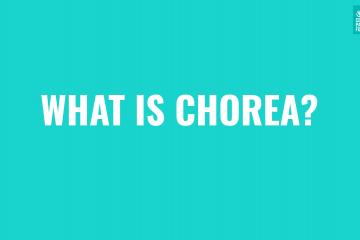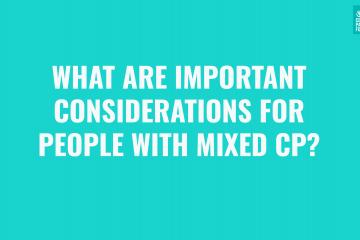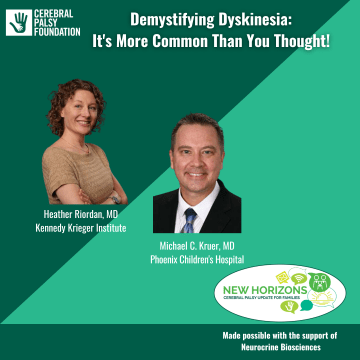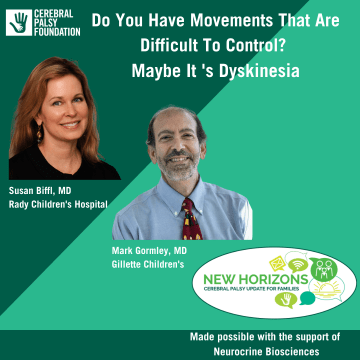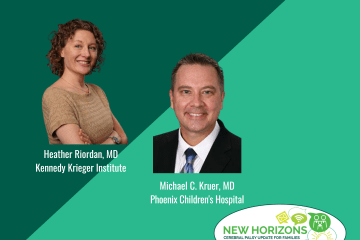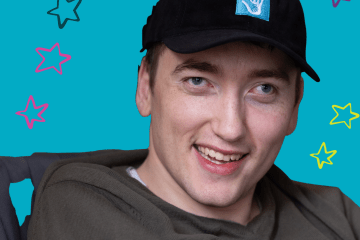Dyskinetic Cerebral Palsy
People who have dyskinetic cerebral palsy, also referred to as dyskinesia, experience involuntary movements that are difficult to control. These movements can be slow, twisting and writhing, or rapid and jerky, and can impact movement in the hands, arms, feet, legs, trunk, neck, and even the face or tongue. Dyskinesia can be especially noticeable when a person attempts to move. It can also vary from day to day or even within the same day, where a person might have tight muscle tone at some times, and normal or loose tone at other times.
Dyskinesia is an umbrella term or "catch all" for three main types of movement disorders in cerebral palsy: dystonia, chorea and athetosis. Sometimes when a person's movements are subtle or complex, and doesn't fit well into any one type of movement or if the provider isn't really comfortable differentiating, the term dyskinesia will be used.
Dyskinetic cerebral palsy is often associated with damage to the parts of the brain called the basal ganglia. The basal ganglia are a group of structures located deep within the brain that are responsible for voluntary motor control, as well as other important functions associated with executive functions, emotions, and behavior.

Dystonia is involuntary, repetitive muscle contractions that cause twisting, awkward or abnormal postures that tend to come and go. These movements are often triggered by voluntary attempts to move or by being moved such as transfers. Dystonia may worsen when a person is tired, excited, upset or with physical touch. Dystonia tends to go away during sleep, but some posturing may be seen during brief moments of being awake. Dystonia can sometimes be painful. It occurs in Dyskinetic CP but also occurs in Spastic CP.
Dystonic postures have a twisting quality to the movement. Common postures include:
- Back arching
- Twisting of the neck
- Twisted extension of the arms or legs
- Swanning (bent) posturing of the fingers
- Intermittent scissoring of the legs
Examples of Dystonia:
- When the person tries to move one body part, A DIFFERENT BODY PART starts moving unintentionally or out of their control.
Someone tries to intentionally move their legs, their arms begin moving unintentionally. Or when they pick something up with their left hand, their right hand also start moving unintentionally.
- During activities that involve other people handling their body, the person starts moving body part(s) that are NOT BEING HANDLED BY OTHERS unintentionally or out of their control.
During transfers, the individual unintentionally arches their back or moves their arms or legs uncontrollably. Or, when doing leg stretches during physical therapy, they unintentionally start moving their arms or hands.
Diagnosing Dystonia:
Dystonia is diagnosed by performing a neurological examination and observing how patients move and respond to stimulation. The Hypertonia Assessment Tool (HAT) is an examination tool that clinicians can use to detect dystonia. The HAT is a seven item tool developed for children/youth between 4 to 19 years old. The HAT is used to differentiate the various types of pediatric hypertonia, namely spasticity, dystonia, and rigidity.
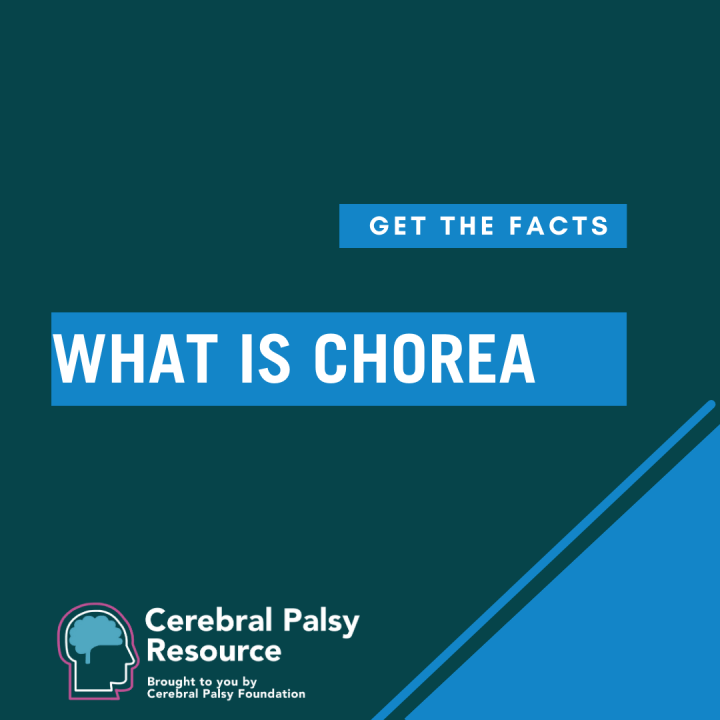
Chorea is characterized as ongoing random-appearing sequence of one or more irregular, brief, involuntary movements or movement fragments. These movements can be jerky or writhing and tend to migrate from one body part to another. It can have a twitchy quality.
- People with chorea may look like they are constantly fidgeting or clumsy, just can't keep the body still.
- Subtle chorea can look like wiggly, distracted movements in an active child; however the person is unable to hold the movement in.
- More pronounced chorea can include flinging movements of the extremities, especially when going through doorways.
- Chorea can affect speech and swallowing.
- Movements will worsen with attempts to move during stress or anxiety and reduce when asleep.
- Chorea may occur with athetosis, and this is known as choreoathetosis.
Diagnosing Chorea
Chorea is best diagnosed by a physician who specializes in movement disorders, such a neurologist, physiatrist, neuro-developmental or developmental pediatrician. They will take a clinical history, perform a neurological examination and observe how an individual moves and responds to stimulation. They may also order neuro-imaging, such as an MRI.
Treatment
The aim of treatment and management is to improve functional outcomes, improve caregiving, prevent complications or declines and increase quality of life.
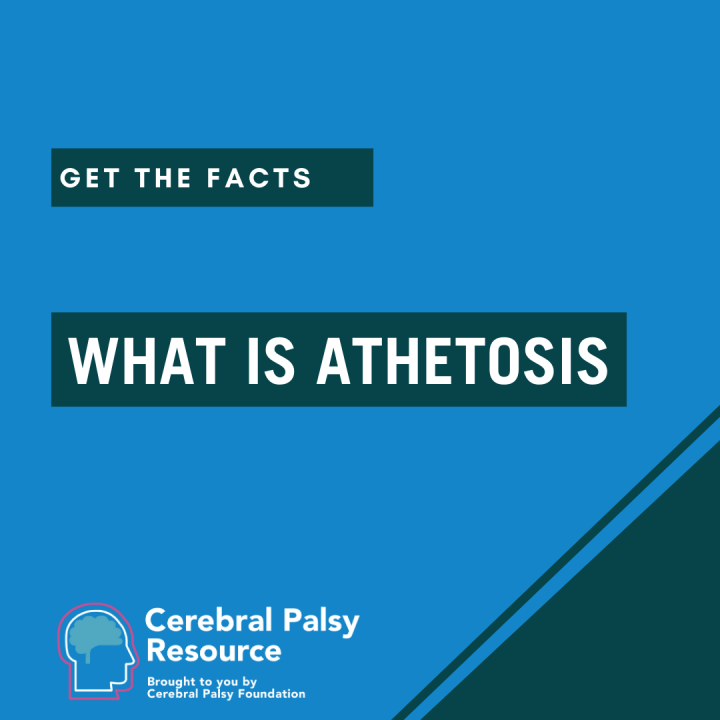
Athetosis is a slow, continuous, involuntary, writhing movement that prevents the ability to maintain a stable posture. Individuals with athetosis appear restless and constantly moving. The movements may look almost like writhing or contorting and tend to migrate from one body part to another. These movements usually affect the hands, arms, legs and feet, but they can affect the whole body, including the muscles of the face, lips and tongue. This means that speech, eating and drinking can all be affected.
Athetosis also impacts muscle tone, meaning that sometimes the individual may be floppy (hypotonic) while other times they will be constantly moving.
- As with the other movement disorders, stress can make it worse.
- Symptoms lessen when the individual is at rest or and can disappear when asleep.
- Unlike dystonia, movements are not sustained, patterned or repetitive.
- Sometimes it is described as a slow form of chorea.
- True Athetosis in cerebral palsy is uncommon and often occurs in combination with Chorea, called Choreathetosis.
Diagnosing Athetosis
Athetosis is best diagnosed by a physician who specializes in movement disorders, such a neurologist, physiatrist, neuro-developmental or developmental pediatrician. They will take a clinical history, perform a neurological examination and observe how the individual moves and responds to stimulation. They may also order neuro-imaging, such as an MRI.
Treatment
The aim of treatment and management is to improve functional outcomes, improve caregiving, prevent complications or declines and increase quality of life.
-
Expert Videos
What is Dyskinesia? 
-
Expert Videos
What is Dystonia? 
-
Expert Videos
What is Chorea? 
-
Expert Videos
What are Mixed Motor Types of Cerebral Palsy? 
-

New Horizons Virtual Town Hall 10 - Demystifying Dyskinesia! Do you or your child have movements that are difficult to control? Is your mobility and function impacted by abnormal movements or do these movements cause pain? If so, you or your child may have Dyskinesia. If you want to learn more, including how it is treated, don't miss this educational Town Hall with experts Dr. Heather Riordan, from Kennedy Krieger Institute, and Dr. Michael Kruer, from Phoenix Children's. -

New Horizons Virtual Town Hall 9 - Do You Have Movements That Are Difficult To Control? Maybe It's Dyskinesia. Do you or your child have movements that are difficult to control? Is your mobility and function impacted by abnormal movements and cause pain? If so, you or your child may have Dyskinesia. If you want to learn more, including how it is treated, please join us on for a new educational Town Hall with experts Dr. Susan Biffl, from Rady Children's Hospital, and Dr. Mark Gormley, from Gillette Children's.
-

Understanding Dystonia: Diagnosis and Treatment Dr. Bhooma Aravamuthan presents Understanding Dystonia: Diagnosis and Treatment at the 2020 AACPDM Community Forum. Moderated by Council Chair, Jen Lyman. -

Dystonia Care Pathway The Dystonia Care Pathway was updated in 2024 based on best available evidence. The goal of the these Care Pathways is to help Health Care Professionals understand the research evidence on the topic so that they can make clinical decisions for the care of the individual.
-

Dystonia Systematic Review This systematic review looks at all available evidence for pharmacological/neurosurgical interventions for managing dystonia in individuals with cerebral palsy to inform the AACPDM care pathway. -

Dyskinetic Cerebral Palsy Functional Impact Scale The Dyskinetic Cerebral Palsy Functional Impact Scale is a new tool useful measuring the functional impact of dyskinesia on children's movements and postures and the perceived impact of dyskinesia on daily activities. It can can help identify priorities for intervention.
"A lot of things will get lumped in under dyskinetic cerebral palsy. It's kind of rare to have cerebral palsy with only one type of tone. Most patients will have a combination of them so it's important to be assessed accurately."



